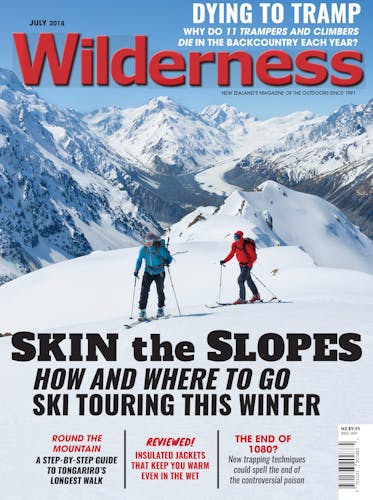Letter of the month
More graffiti spelt ‘Hilary’
I loved the article ‘Sushi’s last climb’ (May 2018) which detailed the trip up and over Pinnacle Peak. I found the reference to Ed Hillary’s name on the wall of Boulder Forks Hut, and speculation over its veracity given it was spelt ‘Hilary’, particularly interesting.
Last summer, while walking the Te Araroa Trail, I stayed at Double Hut near Lake Heron. This hut is famous for bearing the great man’s name. After some hunting around, I found it, with the help of a witty little ditty someone had written on one of the walls to point the way. While certainly being an old inscription, it too was spelt with only one ‘l’, which at the time led me to question its source.
I wasn’t too upset. I’d just that day left Royal Hut, which I had holed up in for a rest after a tiring day over Beuzenberg Peak. Having stayed there the better part of two days, I only noticed the back of the door on my way out of the hut to continue the trail. Here was more New Zealand royalty: Gottlieb Braun-Elwert, Harry Ayers (on Victory in Europe Day no less) and others had signed their names to the door.
Our older huts contain some real treasures in this regard.
– Aaron Schulz, email
– Aaron receives Heinrich Harrer’s classic novel The White Spider from www.unitybooks.co.nz. Readers, send your letter to editor@lifestylepublishing.co.nz for a chance to win.
Click the photos to see the graffiti Aaron references in his letter.
Wilderness Area trapping innovative
I feel it is necessary to make a couple of points about the article ‘Concern at huts and tracks in untouched wilderness’.
The article questioned the placement of management infrastructure into the Adams Wilderness Area for the predator control research that Zero Invasive Predators Ltd (ZIP) is conducting in collaboration with Predator Free 2050 Limited and DOC.
Pest control in Wilderness Areas is commonplace. The Tasman Wilderness Area in Kahurangi National Park has been subjected to multiple aerial 1080 operations in recent years. DOC has two temporary research huts in the area for kiwi and rock wren research. Both huts will be removed when the research is finished. DOC also has a large number of tracking tunnels throughout the wilderness area which are visited every three months.
The research in the Adams Wilderness sets out to test and refine an approach to completely remove possums from large areas and prevent them from re-establishing. Recent breakthroughs in technology may make this possible for the first time in New Zealand.
If the work is successful, then this will provide a new tool to address the extensive damage being done by possums in native forests. In doing so, the predator research work in the Adams Wilderness Area directly supports the goal of a predator-free New Zealand. If we are to achieve this goal, there needs to be innovative research that pushes the boundaries of pest management techniques.
– Lou Sanson, Director General Conservation
Te Hoe Gorge impassable
I read the article ‘Never too old’ (June 2018) with great interest, particularly Bruce Postill’s comment about walking down the Te Hoe Gorge in Whirinaki Forest Park.
My assumption is that he is referring to the gorge between Upper Te Hoe Hut and Central Te Hoe Hut.
On the off-chance that these comments may motivate trampers to follow in his tracks, I would like to offer a word of warning: there are two options to get from Upper Te Hoe to Central Te Hoe. One is to go down the gorge. The second is to take the ridge track. The gorge is the most exciting. The ridge track is just a hard slog.
I have done the gorge route quite a few times. There are two secrets to successfully navigating it: knowing how to get through ‘the cutting’, about 30min downstream from the Upper Te Hoe Hut, and how to bypass the waterfall, about 3hr below the hut.
Unfortunately, when I last walked the gorge in 2011, I found the rock ledge – used to avoid the cutting – had been completely demolished. Only a serious rock climber could get through the cutting and I would therefore not recommend that anyone attempts the gorge route.
If you do reach the cutting, you can easily reverse your steps and take the ridge track, but if heading upstream from Central Te Hoe, it will take about six hours to reach this point.
– David Holroyd, email
Droning on
One thing that wasn’t mentioned in the article ‘Rise of the drones’ (May 2018), was that as well as needing permission from the landowner, a person operating a drone also needs permission from everyone they are flying over. That’s right, if you are having a moment of peace sitting by a waterfall or on a beach and somebody puts a drone up, you can ask them to land it as they do not have your consent to fly over you. (Civil Aviation Authority Rules Part 101, if you want to quote the rules.)
Good on DOC for banning them from national parks, which meant my summer tramping in the South Island was drone-free.
I have seen some amazing drone footage and they certainly have their place in the world of photography, but if someone is flying a drone over you or your property, you can ask them to please land it.
– Tony Dunn, Auckland









